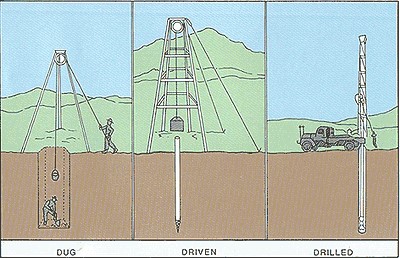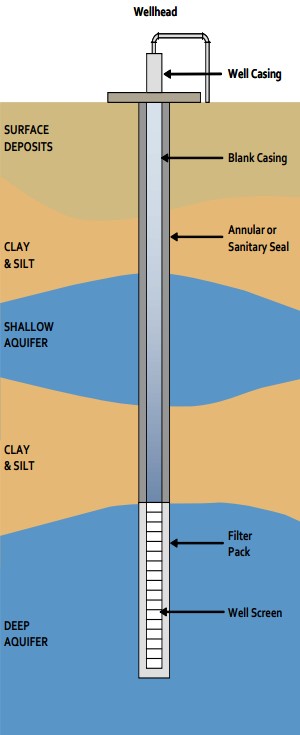Wells
As many as two million water wells tap California’s groundwater, with approximately 7,000 to 15,000 new wells constructed each year. They range from hand-dug, shallow wells to carefully designed large -production wells drilled to great depths.
Groundwater supplies approximately 40 percent of California's total water supply in average water years, and in some regions of the state, up to 60 percent in dry years. To protect this invaluable resource, we must ensure that wells are properly constructed and destroyed at the end of their useful lives, so they do not serve as a pathway for contaminants.
We are responsible for developing minimum well standards for four types of wells, published as DWR Bulletin 74 and for serving as the state clearinghouse for Well Completion Reports.
Tools for Dry Well Susceptibility and Reporting
As California continues to experience climate-driven severe drought conditions, DWR, in coordination with the State Water Resources Control Board, is helping communities throughout the state to be ‘Well Prepared’ to anticipate and address drought-related impacts to drinking water wells by providing important information and resources for counties, local water agencies, groundwater sustainability agencies (GSAs), and well owners to use for drought-related planning and decision-making.
Water Well Basics
Constructing a new well or decommissioning an out of service well is a team effort.
Well owners need to obtain permits from local environmental health agencies or local water districts before construction, modification, or destruction takes place. Any water well construction activities must be performed only by a licensed C-57 Well Drilling Contractor and must meet applicable local and state well standards. Installation, repair, or replacement of a well pump must be performed by either a C-57 Well Drilling Contractor or a C-61/D-21 Machinery and Pumps Contractor. Depending on site conditions, a licensed California geologist or hydrogeologist may be consulted on well siting, design, and/or construction.
Proper well location and construction are essential to the safety and water quality of a well. It is important to maintain safe distances between a private groundwater well and possible sources of contamination. Whenever possible, the well should be located at higher elevations than surrounding areas and above flood levels to decrease the potential for contamination. The well location should be accessible for activities related to maintenance, repair, and eventually, destruction/decommissioning.

Construction of a water well begins with making a hole. Wells are generally classified by construction method as dug/bored, driven, or drilled, as shown in the Figure 1 image.
Dug/bored wells are holes in the ground dug by shovel or backhoe. Dug wells have a large diameter, are shallow, and are not cased continuously. Driven wells are constructed by driving pipe into the ground. Driven wells are shallow and cased continuously. Drilled wells are constructed by percussion or rotary-drilling machines. Drilled wells can be hundreds to thousands of feet deep and use continuous casing.
As the hole is excavated, the well driller logs the depths at which water is produced. This information is used to design the well. Learn more about well drilling and view videos at wellowner.org.

Source: State Water Resources Control Board,
March 2015
Basic well components include the well casing, well screen, filter pack, pump, and well head features. These are shown in Figure 2 and described here. The “well casing” is a metal or plastic pipe that is centered in the hole and is the conduit for water movement through the well. The “well screen” is the perforated section of casing next to the aquifer. It allows water to enter the well, while preventing too much sediment from entering the well. The remainder of the casing is "blank" with no perforations. Once the well casing is inserted, a “filter pack” of sand and/or gravel is placed around the well screen to stabilize the formation, without impairing flow into the well. The rest of the space between the hole and the blank casing (annular space), is sealed with sealing materials to prevent contaminants from flowing through the space. This seal is referred to as the “annular seal” or “sanitary seal.” The well is completed when the pump is installed and the wellhead features are constructed, including a concrete pad which slopes away from the well.
Proper design and construction are key to a well’s success. The well should be carefully located away from septic systems and other pollutant sources to minimize potential for contamination. The annular space should be sealed with materials that meet statewide minimum well standards and local well ordinance requirements.
Simple preventative measures can ensure your well water stays clean:
- Do not store or mix pesticides, fertilizers, lawn-care products, paint or paint cleaners, hazardous cleaning products, gasoline or automotive wastes near the well.
- Establish zones of protection around your well, limited low, medium, and high impact activities as shown in “A Guide for Private Domestic Well Owners”.
- Perform routine maintenance and testing: inspect the well at least once a year for cracks or other possible sources of contamination and test water quality on a regular schedule as described in “A Guide for Private Domestic Well Owners”.
Abandoned wells can be pathways for pollutants to enter groundwater. They also pose a threat to public health and safety – children, animals, and even adults can fall into abandoned wells, causing injury or death. It is the responsibility of the well owner to destroy abandoned wells per the Public Health and Safety Code, Part 9.5, Section 115700.
“Well Decommissioning…There’s a Plan for That” (3-minute video) by the Natural Resources Conservation Service of California provides important information for all landowners to recognize and address abandoned wells with footage from an actual well destruction in Sacramento County. If you know of or suspect an abandoned well, contact your local enforcing agency.
Informational Materials
- The Private Well Class, Regional Rural Community Assistance Partnership (RCAP) and the Illinois State Water Survey, with funding from the U. S. EPA
- A Guide for Private Domestic Well Owners, State Water Resources Control Board, March 2015
- Guía para los Dueños de Pozos Domésticos , Junta Estatal de Control de los Recursos de Agua de California, Marzo de 2015
- Water Well Design and Construction, University of California, Davis with Natural Resources Conservation Service, 2003
Local & Regional Resources
- Well Permitting Agencies are the local agencies responsible for issuing well construction, modification, and destruction permits.
- Groundwater Sustainability Agencies are the local/regional agencies being formed under the 2014 Sustainable Groundwater Management Act to manage groundwater.
State Resources
- Contractors State License Board licenses water well drilling contractors under the C-57 license designation.
- State Water Resources Control Board has broad regulatory authority to protect water quality.
- GAMA Program and GeoTracker GAMA Application maintain groundwater quality information and data.
- Division of Drinking Water permits public water supply systems (serving 200 or more houses).
- Department of Toxic Substance Control provides information on hazardous waste disposal and reporting spills or illegal dumping.
- California Groundwater Association is a non-profit organization representing all segments of the groundwater industry in California.
- Groundwater Resources Association of California is a professional association dedicated to resource management that protects and improves groundwater supply and quality through education and technical leadership.
- California Statewide Groundwater Elevation Monitoring (CASGEM) Program tracks seasonal and long-term groundwater elevation trends in groundwater basins statewide.
- Water Data Library is a database of groundwater level data, water quality data, and various DWR publications.
- SGMA Data Viewer provides access to groundwater related datasets that are organized by the requirements of the Sustainable Groundwater Management Act and the Groundwater Sustainability Plan (GSP) regulations for the purpose of supporting GSP development and implementation.
- California Well Completion Report Map Application provides direct statewide access to copies of Well Completion Reports. Well Completion Reports contain information collected by drilling contractors during the drilling and construction of water wells, including the location, dates of construction, planned use, depth of the well, subsurface geologic units encountered, well construction, and well yield.
- Water Management Planning Tool is an interactive map application that allows you to overlay numerous Geographic Information Systems (GIS) layers onto a map of California. Each planning layer includes a brief description and a location or source where you can find additional information regarding that layer.
National Resources
- U.S. EPA - Private Drinking Water Wells provides information to help homeowners care for their private wells and protect their health.
- Natural Resources Conservation Service provides leadership in a partnership effort to help people conserve, maintain, and improve our natural resources and environment. Financial and technical assistance for well decommissioning may be available.
- National Groundwater Association is a national non-profit organization for the groundwater industry.
- The Groundwater Foundation is a national nonprofit charitable organization dedicated to educate people and inspire action to ensure sustainable, clean groundwater for future generations.
Local Well Permitting Coordination

DWR’s Sustainable Groundwater Management Office has summarized local actions taken by well permitting agencies and groundwater sustainability agencies to comply with the March 28, 2022 Executive Order N-7-22, paragraph 9 (superseded by Executive Order N-3-23, paragraph 4 on February 13, 2023), which included new well permitting requirements for local agencies to prepare for and lessen the effects of several years of intense drought conditions. On September 5, 2024, the provisions of these Executive Orders related to well permitting were rescinded by Executive Order N-3-24. The Groundwater Well Permitting: Observations and Analysis of Executive Orders N-7-22 and N-3-23 report includes a summary of various approaches taken by local agencies to comply with the Executive Orders, observations of groundwater conditions that occurred while these actions were taken, and policy recommendations that can be used to develop future solutions to align land use planning, well permitting, and groundwater management and use.
Contacts
Northern Region
April Scholzen
Water Resources Engineering Associate (Spec)
2440 Main Street
Red Bluff, CA 96080
530-529-7368 (office)
530-529-7322 (fax)
North Central Region
Leslie Rodriguez Serrano
Water Resources Engineer
Groundwater Supply & Special Studies Section
3500 Industrial Blvd
West Sacramento, CA 95691
916-820-8232
916-376-9676 (fax)
South Central Region
Chris Guevara
Water Resources Tech. II
691 N. Laverne Ave Suite 104
Fresno, CA 93727-6820
559-552-4450 (office)
559-920-2537 (cell)
916-744-5009 (fax)
Southern Region
Blanca Zendejas
Junior Engineering Technician
770 Fairmont Avenue, Suite 200
Glendale, CA 91203-1035
818-621-9529 (cell)
DWR Headquarters
Well Standards
Julie Haas
Senior Engineer, Water Resources
715 P Street
Sacramento CA 95814
916-326-9964
Julie.Haas@water.ca.gov
Well Completion Reports/OSWCR
OSWCR_Admin@water.ca.gov
